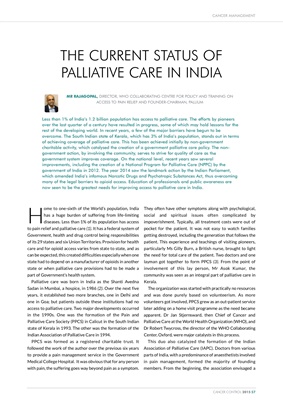
CANCER MANAGEMENT
CANCER CONTROL 2015 57
H
ome to one-sixth of the World's population, India
has a huge burden of suffering from life-limiting
diseases. Less than 1% of its population has access
to pain relief and palliative care (1). It has a federal system of
Government, health and drug control being responsibilities
of its 29 states and six Union Territories. Provision for health
care and for opioid access varies from state to state, and as
can be expected, this created difficulties especially when one
state had to depend on a manufacturer of opioids in another
state or when palliative care provisions had to be made a
part of Government's health system.
Palliative care was born in India as the Shanti Avedna
Sadan in Mumbai, a hospice, in 1986 (2). Over the next five
years, it established two more branches, one in Delhi and
one in Goa; but patients outside these institutions had no
access to palliative care. Two major developments occurred
in the 1990s. One was the formation of the Pain and
Palliative Care Society (PPCS) in Calicut in the South Indian
state of Kerala in 1993. The other was the formation of the
Indian Association of Palliative Care in 1994.
PPCS was formed as a registered charitable trust. It
followed the work of the author over the previous six years
to provide a pain management service in the Government
Medical College Hospital. It was obvious that for any person
with pain, the suffering goes way beyond pain as a symptom.
They often have other symptoms along with psychological,
social and spiritual issues often complicated by
impoverishment. Typically, all treatment costs were out of
pocket for the patient. It was not easy to watch families
getting destroyed, including the generation that follows the
patient. This experience and teachings of visiting pioneers,
particularly Ms Gilly Burn, a British nurse, brought to light
the need for total care of the patient. Two doctors and one
layman got together to form PPCS (3). From the point of
involvement of this lay person, Mr Asok Kumar, the
community was seen as an integral part of palliative care in
Kerala.
The organization was started with practically no resources
and was done purely based on volunteerism. As more
volunteers got involved, PPCS grew as an out-patient service
later adding on a home visit programme as the need became
apparent. Dr Jan Stjernsward, then Chief of Cancer and
Palliative Care at the World Health Organization (WHO), and
Dr Robert Twycross, the director of the WHO Collaborating
Center, Oxford, were major catalysts in this process.
This duo also catalyzed the formation of the Indian
Association of Palliative Care (IAPC). Doctors from various
parts of India, with a predominance of anaesthetists involved
in pain management, formed the majority of founding
members. From the beginning, the association envisaged a
THE CURRENT STATUS OF
PALLIATIVE CARE IN INDIA
MR RAJAGOPAL, DIRECTOR, WHO COLLABORATING CENTRE FOR POLICY AND TRAINING ON
ACCESS TO PAIN RELIEF AND FOUNDER-CHAIRMAN, PALLIUM
Less than 1% of India's 1.2 billion population has access to palliative care. The efforts by pioneers
over the last quarter of a century have resulted in progress, some of which may hold lessons for the
rest of the developing world. In recent years, a few of the major barriers have begun to be
overcome. The South Indian state of Kerala, which has 3% of India's population, stands out in terms
of achieving coverage of palliative care. This has been achieved initially by non-government
charitable activity, which catalysed the creation of a government palliative care policy. The nongovernment
action, by involving the community, serves to strive for quality of care as the
government system improves coverage. On the national level, recent years saw several
improvements, including the creation of a National Program for Palliative Care (NPPC) by the
government of India in 2012. The year 2014 saw the landmark action by the Indian Parliament,
which amended India's infamous Narcotic Drugs and Psychotropic Substances Act, thus overcoming
many of the legal barriers to opioid access. Education of professionals and public awareness are
now seen to be the greatest needs for improving access to palliative care in India.